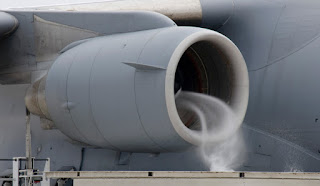NASA's Aviation Safety Program is developing technology for improved sensors to help spot changes in vibration, speed, temperature and emissions which are symptomatic of engine glitches. These advanced sensors could alert ground crews to problems that can be eliminated with preventive maintenance before becoming serious safety concerns. Ultimately, the sensors could alert pilots to the presence of destructive volcanic ash particles too small for the eyes to see, giving more time for evasive action to prevent engine damage in flight.
Letting a jet engine suck up foreign objects usually is a no-no, but engineers at NASA's Dryden Flight Research Center will bend the rules in an upcoming experiment with a U.S. Air Force C-17 cargo transport. The cereal and crayons will leave a colorful trail of grains and wax that the researchers can see and study to gauge how well the sensors work.
Dryden engineers ran a similar test using water in December 2011 to lay the groundwork for more complex experiments. They operated the C-17 in normal use and simulated fault conditions after outfitting one of its two Pratt & Whitney F117 turbofan engines military versions of Pratt & Whitney's commercial airline PW-2000 turbofan engines with the advanced sensors.
For more information about: Low cost business airline companies

No comments:
Post a Comment